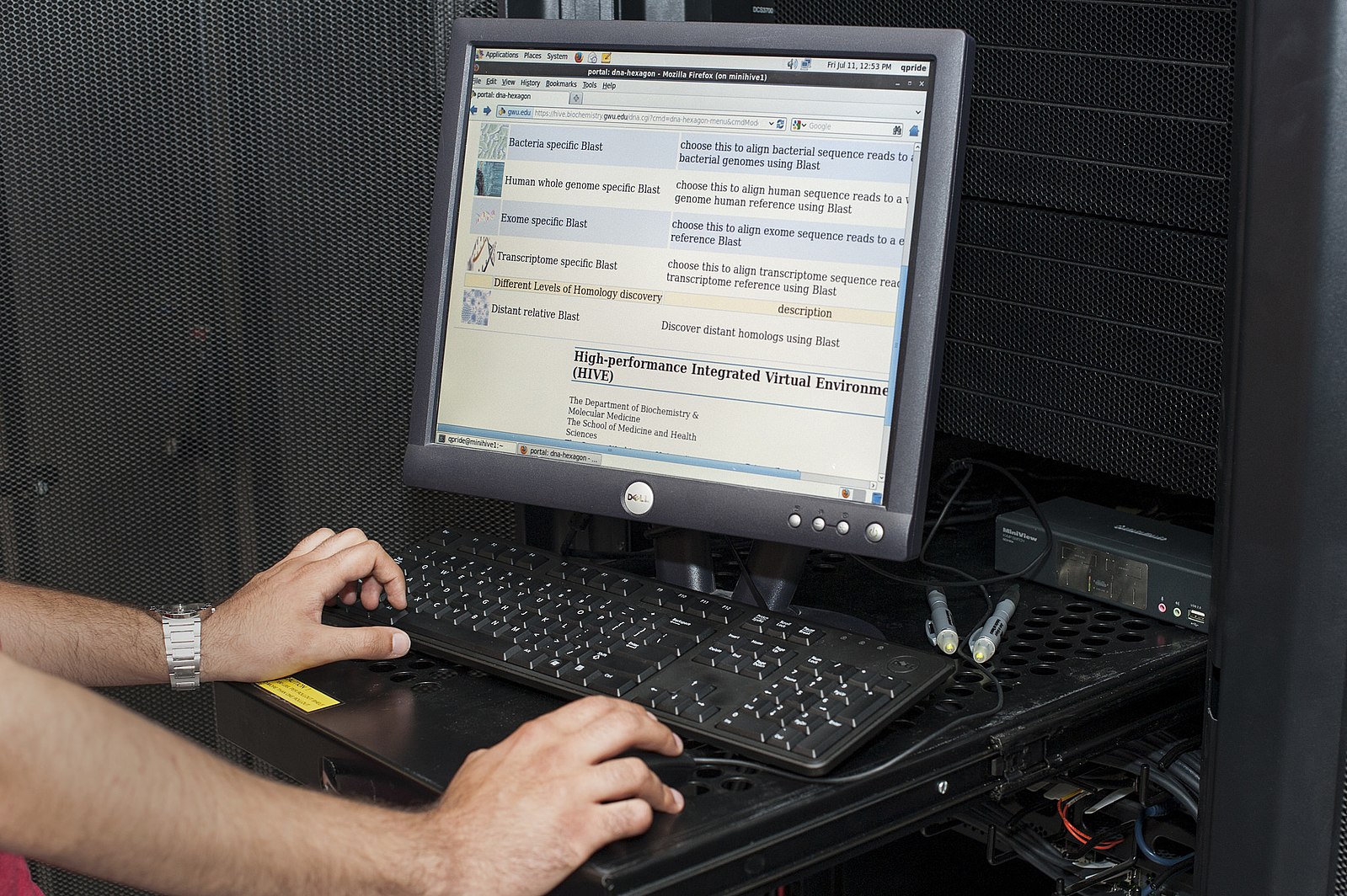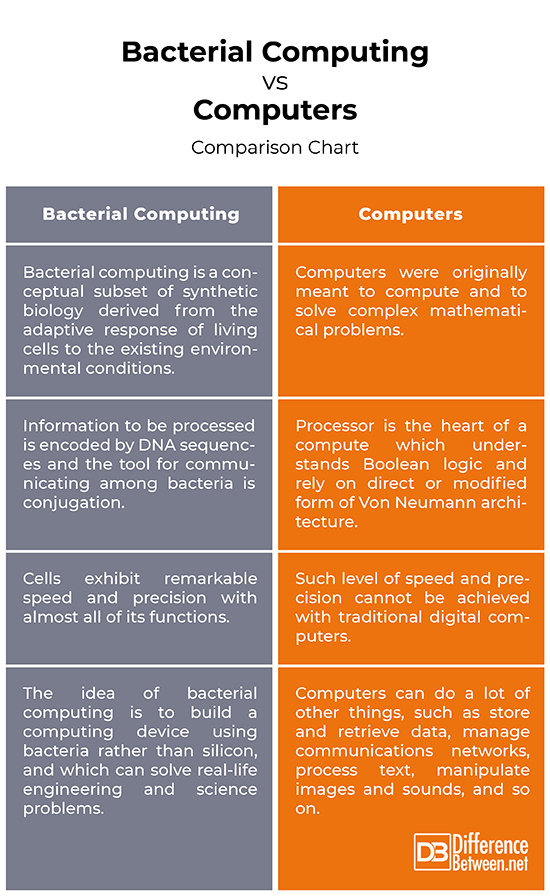Difference Between Bacterial Computing and Computers
Computers are literally evolving, owing to the technological revolution. It seems the computers have now occupied every single space in life. Many historical circumstances outside of commercial developments have made computers into an indispensable tool. Early computers were conceived for computational purposes but today, computing is the least important thing that modern-day computers do. It was to solve equations that the electronic digital computers were invented. The main reason for the evolution of computers is that people wanted to work faster and more efficiently and effectively. While the tech world worries about smartphones, laptops, and tablets, biologists are leaving the traditional computers behind altogether.
As the world moves closer and closer to the integration of technology into every aspect of life, some scientists have developed genetically engineered bacteria that could perform computation work as a computer. These computers can perform complicated computing tasks with efficient communication via plasmids. Sophisticated molecular techniques have been developed recently to genetically modify bacteria. Using such conjugation, DNA molecules can be transmitted from one cell to another. Current bacterial computing models are designed to solve certain specific biological applications, such as bacteria signal pathway detecting.

What is Bacterial Computing?
Bacterial computing is a conceptual subset of synthetic biology derived from the adaptive response of living cells to the existing environmental conditions. The purpose of bacterial computing is to build bacterial computers to solve complex mathematical problems. Bacteria contain a well-developed cellular structure responsible for some of their unique biological structures and pathogenicity. They are able to adapt and explore complex environments. Sophisticated molecular techniques have been developed recently to genetically modify bacteria. Scientists have been working for years to make cells into computers. One appeal of bacterial computing is that bacteria are very cheap to manufacture. Bacterial computing was actually coined with the purpose of building biological machines, which are developed to solve real-life engineering and science problems. Bacterial computing models belong to the field of bio-computing models, such as DNA computing models and membrane computing models.

What is Computer?
The word computer originally meant a person who carried out calculations or computations. The meaning of computer remained the same till the mid-twentieth century. It was around 1945 that the named was carried over to machines. Computers were originally meant to compute: to solve complex mathematical problems, according to the dictionary which still defines that word. Early computers were conceived as calculating devices. One can classify computing machines by the technology from which they were constructed, their operating principle, and whether they were designed to process numbers or more general kinds of data. Today, computers can do a lot of other things, such as store and retrieve data, manage communications networks, process text, manipulate images and sounds, and so on. Computers are basically circuits that do all of those things and more by transforming them into a mathematical language.
Difference between Bacterial Computing and Computers
Basics
– Bacterial computing refers to the development and use of bacterial computers to solve complex mathematics problems. Bacterial computing is a conceptual subset of synthetic biology derived from the adaptive response of living cells to the existing environmental conditions. Practically, bacterial computing proves the possibility of using bacteria for solving computational problems. Computers were originally meant to compute: to solve complex mathematical problems. At the heart of every computer, lies a processor which understands Boolean logic and rely on direct or modified form of Von Neumann architecture. Early computers were conceived as calculating devices.
Purpose
– Bacterial computing is a known candidate in natural computing, the purpose of which is to construct bacterial computers for solving complex problems. Bacterial computing was originally coined with the purpose of building biological machines, which are developed to solve real-life engineering and science problems. Although the concept of bacterial computing may once have been a distant dream and imagination of sci-fi writers and readers alike, it is fast becoming a technological reality. These computers can perform complicated computing tasks with efficient communication via plasmids.
Concept
– A computer processor primarily works in sequential mode; it can perform millions of calculations per second but at the heart of the processor, lays a system which can only perform in sequential mode and therefore, can only manage sequential inputs. In general bacterial computing model, information to be processed is encoded by DNA sequences and the tool for communicating among bacteria is conjugation. Using such conjugation, DNA molecules can be transmitted from one cell to another. The idea of bacterial computing is to build a computing device using bacteria rather than silicon.
Bacterial Computing vs. Computers: Comparison Chart

Summary of Bacterial Computing and Computers
Like any computer program which generates desired output based on the predefined set of input values, bacterial cells undergoes similar logical steps to make a decision on their division. Cells exhibit tremendous capability to handle perturbations of its surrounding meaning they exhibit significant level of robustness both internally and externally. Plus they exhibit remarkable speed and precision with almost all of its functions. Many scientists and researchers are now investigating the computational abilities of these cells, which in turn form the basic foundation of the study of bacterial computing. The idea of bacterial computing is to build a computing device using bacteria rather than silicon.
- Difference Between Caucus and Primary - June 18, 2024
- Difference Between PPO and POS - May 30, 2024
- Difference Between RFID and NFC - May 28, 2024
Search DifferenceBetween.net :
Leave a Response
References :
[0]Image credit: https://commons.wikimedia.org/wiki/File:HIVE_Computing_at_FDA_(1767).jpg
[1]Image credit: https://en.wikipedia.org/wiki/Desktop_computer#/media/File:Desktop_computer_clipart_-_Yellow_theme.svg
[2]Mandal, Jyotsna K. et al. Handbook of Research on Natural Computing for Optimization Problems. Hershey, Pennsylvania: IGI Global, 2016. Print
[3]Ceruzzi, Paul E. A History of Modern Computing. Cambridge, Masachusetts: MIT Press, 2003. Print
[4]Zeng, Xiangxiang, et al. Molecular Computing and Bioinformatics. Basel, Switzerland: MDPI, 2019. Print
[5]Durand-Lose, Jerome and Natasa Jonoska. Unconventional Computation and Natural Computation: 11th International Conference, UCNC 2012, Orléans, France, September 3-7, 2012, Proceedings. Berlin, Germany: Springer, 2012. Print
